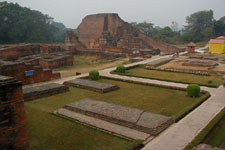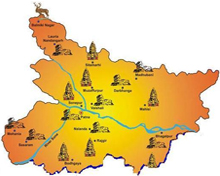About Bihar
 For an in-depth understanding of Bihar, you should know three main things - its history, unique geography and reasons for the backwardness. 'Bihar' had its origin in the Sanskrit word 'Vihara' referring to Buddhist monasteries that dotted the region in the ancient and medieval periods.
For an in-depth understanding of Bihar, you should know three main things - its history, unique geography and reasons for the backwardness. 'Bihar' had its origin in the Sanskrit word 'Vihara' referring to Buddhist monasteries that dotted the region in the ancient and medieval periods.
Spread over an area of 94,163 sq km and having the third largest population in the country at 10 crore, Bihar in a way is characterised by poverty, social backwardness and lack of industrial progress despite being the forerunner to modern civilisation with its grand kingdoms and emperors who ruled over a most prosperous region of the world.
The present day Bihar is landlocked with Uttar Pradesh in the west, Nepal to the north, West Bengal covering up the east and the newly carved state Jharkhand (formed in 2000) to the south. The fertile plains where a range of crops are grown are divided into two parts by Ganga river which flows from the west to the east.
Nearly 85% of people live in villages across 38 districts of the state. The Bihari migrants including the working class are spread across India and they are known for their hard work and tenacity of purpose.
This is a state with youngest population as 58% of Biharis are below the age of 25 and the denizens speak a number of dialects - Bhojpuri, Maithili, Magahi, Bajjika and Angika - which have their own lineage.
Hindi and Urdu are the official languages of the state and among the many dialects being spoken, only Maithili has got recognition from the Central government.
Glorious History of Bihar

Many kingdoms and republics (Mahajanapadas, that is, great empires) flourished in Bihar which contributed much to the growth of Indian subcontinent in terms of science, arts and culture, political governance, rule of law and learning.
The kingdoms of Magadha (1,200 B.C. - 322 B.C.), Videha (850-500 B.C.), Anga (600 B.C.) and the Vajji confederation (600 B.C.) along with other Mahajanapadas had existed in the present day Bihar setting new benchmarks in man's quest for progress through the civilisational process.
One of the first known republics in the world, Licchavi existed in this region even before the birth of Mahavira (Circa 599 B.C.).
Earliest myths and legends of Hinduism (termed as Sanatana Dharma) are associated with Bihar. Goddess Sita, the consort of Lord Rama, was a princess of Bihar. She was the daughter of King Janak of Videha.
Golden Age of Bihar
The classical Gupta dynasty (320-500 C.E.) of Bihar in the Magadha kingdom was known to have been a period of renaissance in ancient India with great activities in learning, arts, science and other forms of governance.
Moreover, this golden age of ancient India was marked by many inventions and discoveries in science and engineering. A new wave of progress swept across other fields like arts, literature, logic, mathematics, astronomy, religion and philosophy, all of which contributed to the growth of Hinduism as a renowned culture
It was in Bihar that Prince Gautam attained enlightenment to become Buddha at the present Bodh Gaya district. And this led to the birth of Buddhism which was followed by the emergence of Jainism, another great religion founded by Lord Mahavira.